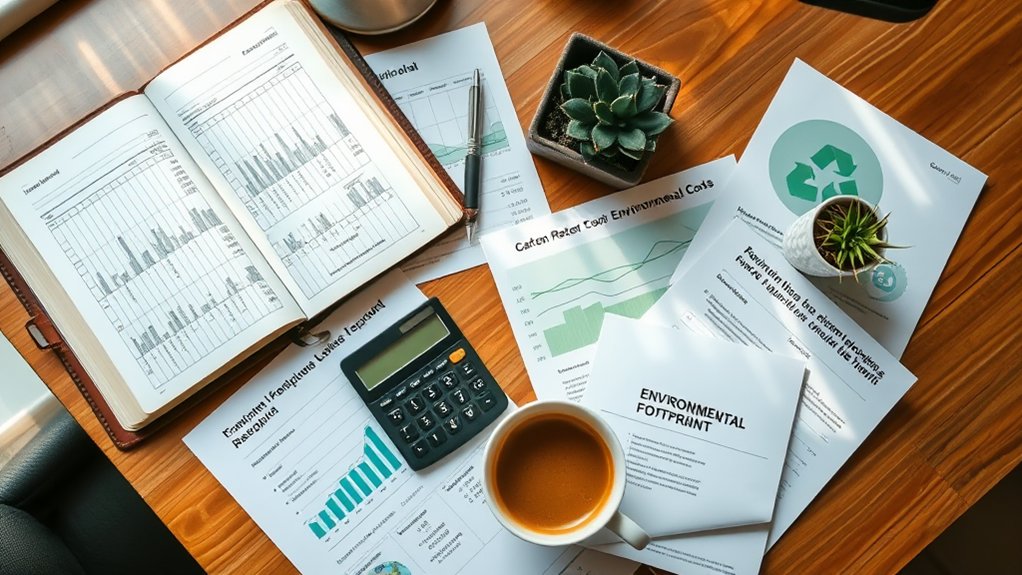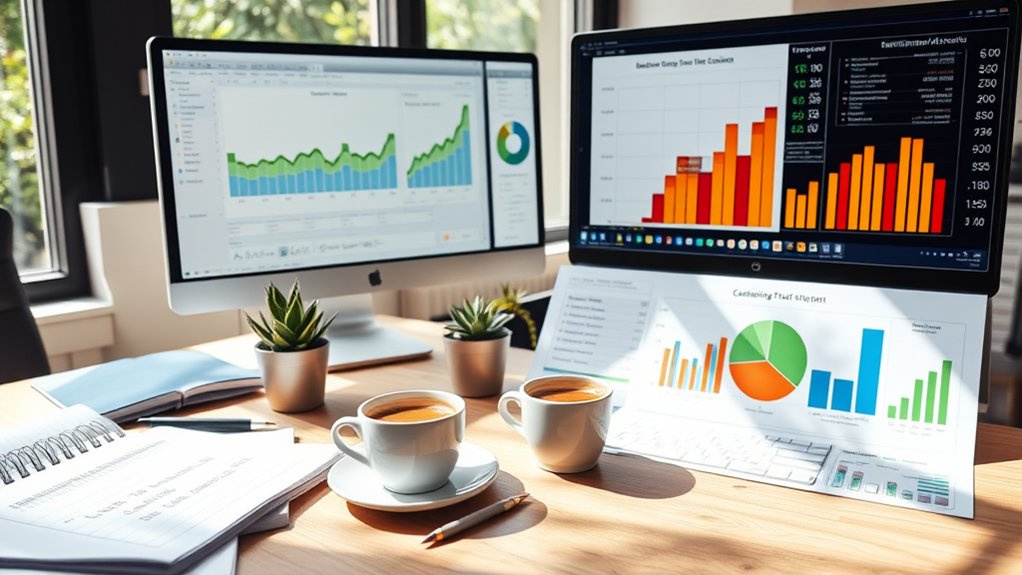To analyze environmental impact costs through bookkeeping, I recommend setting up dedicated tracking systems for five key categories: prevention, detection, internal failures, external failures, and compliance expenses. You’ll need to record both direct costs (resource consumption, waste management) and indirect costs (environmental liability, regulatory compliance) in separate ledgers. I use standardized metrics like carbon emissions, waste volumes, and resource usage data to quantify impacts, letting you transform environmental data into actionable financial insights.
Understanding Environmental Cost Categories in Accounting

While traditional accounting focuses primarily on financial transactions, environmental cost accounting expands the scope to capture both direct and indirect environmental impacts of business operations. I categorize these costs into four key areas: prevention costs (emissions control systems), detection costs (environmental monitoring), internal failure costs (waste disposal), and external failure costs (environmental cleanup).
Setting Up Environmental Impact Tracking Systems
I’ll help you establish a robust environmental impact tracking system by focusing on three critical components: measurable metrics like carbon emissions and waste volumes, properly structured data entry categories that align with regulatory requirements, and standardized reporting parameters that enable trend analysis. You’ll need to configure your accounting software to capture both direct environmental costs and indirect impacts through custom fields and cost allocation methods. Your system’s success depends on defining clear data collection protocols and establishing automated calculations that transform raw environmental data into meaningful financial insights.
Track Essential Impact Metrics
Setting up a robust environmental impact tracking system begins with identifying three core metric categories: resource consumption, waste generation, and emissions output.
I track electricity usage in kilowatt-hours, water consumption in gallons, and raw material utilization by weight. For waste metrics, I measure landfill tonnage, recycling rates, and hazardous material disposal costs. My emissions tracking covers direct CO2 output, volatile organic compounds (VOCs), and particulate matter.
I’ve found that maintaining detailed spreadsheets with monthly data points enables me to identify trends, forecast future impacts, and calculate precise return on investment for green initiatives.
Configure Data Entry Categories
Building on our established metrics framework, the next phase involves structuring specific data entry categories to capture environmental impact information systematically. I recommend configuring separate ledger accounts for energy consumption, water usage, waste management, carbon emissions, and raw material inputs. Each category must include both quantity and cost fields to enable thorough analysis.
I’ll help you set up subcategories that track direct versus indirect impacts, allowing you to pinpoint areas with the highest environmental costs. By organizing data this way, you’ll gain powerful insights into operational efficiency while maintaining precise control over your environmental footprint.
Establish Reporting Parameters
Once you’ve configured your data entry categories, establishing clear reporting parameters becomes critical for tracking environmental impacts effectively. I recommend implementing specific metrics and timelines that align with your strategic objectives while enabling granular analysis of your environmental footprint.
- Set precise measurement intervals (daily, weekly, monthly) to capture temporal patterns
- Define threshold values that trigger automated alerts for resource usage spikes
- Establish standardized reporting templates with cross-departmental KPIs
- Create customized dashboards that display real-time carbon metrics and cost correlations
I’ve found this structured approach guarantees you’ll maintain data consistency while empowering decision-making through actionable environmental intelligence.
Measuring and Recording Resource Consumption Data

To accurately track environmental costs, organizations must establish systematic methods for measuring and recording resource consumption across all operational areas. I’ll show you how to implement real-time monitoring systems that capture utility usage, waste generation, and carbon emissions. You’ll need to install smart meters for electricity, water, and gas consumption, while implementing digital tracking systems for material inputs and outputs.
I recommend creating detailed spreadsheets that break down resource usage by department, process, and time period. This granular data collection enables you to identify inefficiencies, establish baselines, and quantify the financial impact of your environmental initiatives.
Calculating Direct and Indirect Environmental Expenses
Environmental expenses fall into two distinct categories that require separate calculation methods and tracking systems. I track direct costs through immediate resource consumption and waste management, while indirect expenses emerge from secondary environmental impacts and regulatory compliance.
For precise analysis, I recommend these critical calculation steps:
- Quantify direct resource usage costs (water, energy, raw materials)
- Calculate waste disposal and treatment expenses
- Determine indirect compliance costs (permits, reporting, audits)
- Assess environmental liability and risk management expenses
I maintain separate ledgers for each category, enabling granular analysis of our environmental impact costs against operational benchmarks and regulatory thresholds.
Integrating Environmental Metrics With Financial Reports

I’ll show you how to systematically connect environmental performance indicators with traditional financial statements by categorizing costs like emissions, waste disposal, and compliance into specific expense accounts. By tracking quantitative resource usage data points – including water consumption (gallons), energy usage (kWh), and waste output (tons) – you’ll generate standardized metrics that align with accounting periods. These environmental metrics can then be directly linked to corresponding general ledger accounts, enabling integrated reporting that pairs financial results with sustainability impact data.
Recording Environmental Expense Categories
When tracking environmental costs in financial reports, organizations must establish clear expense categories that align both monetary and ecological metrics. I’ll break down the key categories you need to monitor:
- Direct environmental compliance costs – permits, testing, monitoring equipment
- Preventive measures and mitigation expenses – emission controls, waste treatment systems
- Indirect environmental impact costs – energy efficiency upgrades, sustainable material sourcing
- Environmental liability provisions – potential cleanup costs, regulatory penalties
Tracking Resource Usage Data
To effectively merge financial data with ecological metrics, organizations must implement robust resource tracking systems that capture both monetary costs and consumption patterns. I’ll help you establish quantifiable measurements for water usage, energy consumption, waste generation, and raw material inputs. You’ll need to create tracking codes that link each resource to specific cost centers and operational activities.
I recommend integrating smart meters, IoT sensors, and automated data collection tools to monitor real-time usage. You’ll gain granular insights by recording consumption rates, peak demand periods, and seasonal variations. This data enables you to identify inefficiencies, optimize resource allocation, and calculate precise environmental impact costs.
Linking Metrics to Accounts
The seamless integration of environmental metrics with traditional accounting systems requires establishing clear linkages between resource consumption data and financial accounts. I’ve found that linking specific metrics to corresponding cost centers empowers precise tracking of environmental impacts across operations.
- Map utility consumption data directly to expense accounts, correlating kilowatt hours to actual energy costs
- Link water usage metrics with corresponding utility payment entries
- Connect waste management data to disposal contractor expenses
- Assign carbon footprint calculations to relevant transportation and production accounts
This integration enables me to analyze environmental costs within standard financial reports, driving data-driven sustainability decisions while maintaining rigorous accounting controls.
Leveraging Environmental Data for Strategic Decision Making
Modern organizations can gain significant competitive advantages by converting environmental data into actionable strategic insights. I’ll show you how to transform your environmental metrics into strategic decisions that drive profitability and sustainability.
| Strategic Focus | Action Steps |
|---|---|
| Cost Reduction | Identify resource waste patterns |
| Risk Management | Map regulatory compliance gaps |
| Market Position | Track competitor sustainability scores |
| Innovation | Monitor emerging green technologies |
I leverage this data to make informed decisions about capital investments, process improvements, and market positioning. By analyzing trends in environmental costs, I can pinpoint opportunities for competitive differentiation while minimizing regulatory risks and operational inefficiencies.









